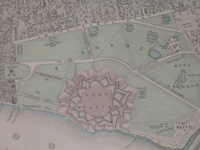Chapter 57: 562-569
Page 562
Chester TownChester is a town in Orange County, New York, United States... The town is named after another city in Great Britain. Chester contains a village, also called Chester. The town was first settled around 1721. The economy of the early town was based on dairy products. From WIKI
The Black Hole of Calcutta
See page 483.
Fort William
Fort William is a fort built in Calcutta on the Eastern banks of the River Hooghly, the major distributary of the River Ganges, during the early years of the Bengal Presidency of British India. It was named after King William III of England. In front of the Fort is the Maidan, which used to be a part of the Fort and is the largest urban park in Calcutta. From WIKI
Page 563
Bengal
See page 404.
Howdah
A howdah, or houdah, is a carriage which is positioned on the back of an elephant, or occasionally some other animal, used most often in the past to carry wealthy people or for use in hunting or warfare. It was also a symbol of wealth for the owner, and as a result were decorated with expensive gems. From WIKI
Page 564
Polonaises
A polonaise (originally robe à la Polonaise) is a woman's garment of the later 1770s and 1780s or a similar revival style of the 1880s inspired by Polish national costume, consisting of a gown with a fitted bodice and cutaway, draped and poufed overskirt, worn over an underskirt or petticoat. The eighteenth century polonaise (also referred to as a milkmaid dress) was a conscious imitation of rustic country women's habit of tucking their outer gowns up to keep them out of the muck. From WIKI
Sacques
The robe à la française or sack-back gown with flowing pleats from the shoulders was originally an undress fashion. At its most informal, this gown was unfitted both front and back and called a sacque. Later, for formal wear, the front was fitted to the body by means of a tightly-laced underbodice, while the back fell in loose box pleats called "Watteau pleats" from their appearance in the paintings of Antoine Watteau. From WIKI
Eyre Coote
See page 478.
Sons of Liberty
The Sons of Liberty was a secret organization of American patriots which originated in the Thirteen Colonies during the American Revolution. British authorities and their supporters, known as Loyalists, considered the Sons of Liberty as seditious rebels, referring to them as "Sons of Violence" and "Sons of Iniquity." Patriots attacked the apparatus and symbols of British authority and power such as property of the gentry, customs officers, East India Company tea, and as the war approached, vocal supporters of the Crown. From WIKI Also, see page 406.
Info on Sons of Liberty Activities in New-York:
HERE and HERE.
Stamp Act
See page 395.
Mr. Pitt
William Pitt, 1st Earl of Chatham PC (15 November 1708 – 11 May 1778) was a British Whig statesman who achieved his greatest fame leading Britain during the Seven Years' War (known as the French and Indian War in North America). He again led the country (holding the official title of Lord Privy Seal) between 1766-68. He is often known as William Pitt, the Elder to distinguish him from his son, William Pitt, the Younger. He was also known as The Great Commoner, because of his long-standing refusal to accept a title. The major American city of Pittsburgh, Pennsylvania, is named after him. From WIKI
Massapequa
Massapequa is a hamlet located in Nassau County, New York. A suburb on the South Shore of Long Island in the Town of Oyster Bay. For many years it was reported that Massapequa was one of the 13 tribes of Long Island. Later research says that it was just a Native American name for the location. From WIKI
Page 565
Mais oui
That's right
Prometheus
See page 372.
Cap'n Kennedy
Captain Archibald Kennedy, 11th Earl of Cassilis (bef. 1736 – 30 December 1794) was a Scottish peer, the son of Archibald Kennedy, the descendant of the second son of the 3rd earl. He lived in New York City at 1 Broadway in the Kennedy mansion until he was recalled to succeeded to the Earldom on the death of the 10th earl, who had died without male issue. From WIKI
